created, $=dv.current().file.ctime & modified, =this.modified
tags:losty2025
rel: Survey of Being Lost Wild Geese Returning - Chinese Reversible Poems by Michele Metail
Why I'm reading this
I love mazes and am trying to explore for Survey of Being Lost. The idea of being stuck in a maze or exploring/confused maps to a lot of situations. This is an older book and I love the typeface and illustrations of the mazes.
I’ve been through large hedge-mazes and corn mazes but would be interested in finding some obscure mazes to roam around as a day trip. I’m guessing there are natural “mazes” that I’d be more reluctant to go in (I’d never take up caving.)
The modern department store, like a supermarket, has a maze-like quality and is a relatively new historically. I wonder if we’ll drift towards increasingly maze-like, geometric traps for consumers.
The hedge-maze, which is the only type with which most of us have a first- hand acquaintance, is generally felt to be a survival of a romantic age, even though we esteem its function as nothing higher than that of a playground for children.
Thought
A maze is a path or collection of paths, typically from an entrance to a goal.
So a maze is a collection.
What are parts of mazes? When does something become maze-like? There’s a bit of that problem where removal of one item, doesn’t make the collective item disappear but successive removals will remove all elements. There comes an indeterminate point where the stack isn’t anymore a stack. I forget the name I want to say it’s the Haystack problem.
edit: I’m an idiot, it’s the Sorites paradox of the Heap or problem of the heap.
The text mentions the hedges as “dark yew alleys” so I’m thinking of the city as a maze like in Italo Calvino’s Invisible Cities, but an individual alley in the city isn’t maze-like. But two connected alleys still isn’t maze like, but at some point the connections do become maze-like.
We cannot, for instance, say that it is “a tortuous branched path designed to baffle or deceive those who attempt to find the goal to which it leads,” for, though that description holds good in some cases, it ignores the many cases in which there is only one path, without branches, and therefore no intent to baffle or mislead, and others again in which there is no definite “goal.” We cannot say that it is a winding path “bounded by walls or hedges,” for in many instances there are neither walls nor hedges.
We shall see that the labyrinth-idea was adopted and developed by the Christian Church in the Middle Ages, and will note its progress as a medium of horticultural embellishment.
Egyptian
We accept that modern construction techniques allow architects to craft their works.
Regarding earlier works, like the Pyramids:
One can imagine, then, what a profound effect these massive edifices must have exerted on the minds of travellers in earlier ages.
Herodotus, spoken as the father of history, traveled a considerable amount during his 60 years of life. He was poetic and exaggerated.
Even the pyramids, he tells us, were surpassed by the Labyrinth.
NOTE
Following the collapse of the Western Roman Empire, the ruins of the Labyrinth were quarried for stone, and after most of the stones had been carted away, the location of the structure was gradually forgotten.1
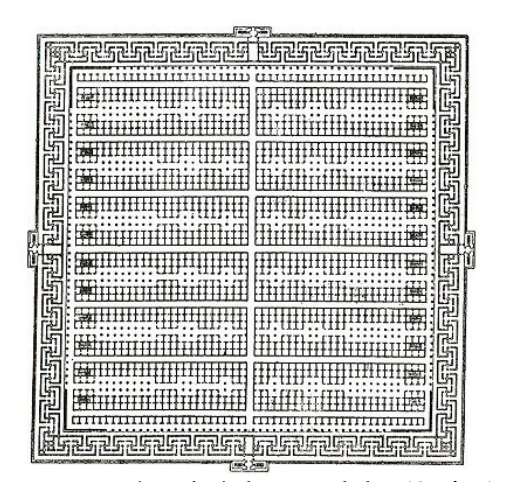
Whatever may have been its original object, it afforded several generations the advantages of a most convenient stone-quarry
Cretan
Theseus and the Minotaur
Daedalus had devised an ingenious structure, the “Labyrinth,” so contrived that if anybody were placed therein he would find it practically impossible to discover the exit without a guide.
Maidens were being given as tribute. Theseus volunteers to be tribute, to end this. Ariadne gave a clue of thread (attached to the entrance) and a sword.
Italian Etruscan Labyrinth
When speaking of the Labyrinth of Crete he says, “We must not compare this to what we see traced upon our mosaic pavements or to the mazes formed in the fields for the entertainment of children, and thus suppose it to be a narrow path along which we may walk for many miles together, but we must picture to ourselves an edifice with many doors and galleries which mislead the visitor… .” This passage shows that the term “labyrinth” had come to have a fairly broad significance. It had long been used in a metaphorical sense, even as we find Plato, over four centuries earlier, employing it to describe an elaborate argument. We also find it applied by extension to other objects, such as traps for fish, to judge by a certain passage in the works of Theocritus.
Ancient Art
Meander Designs - is a decorative border constructed from a continuous line, shaped into a repeated motif. Among some Italians, these patterns are known as “Greek Lines”.
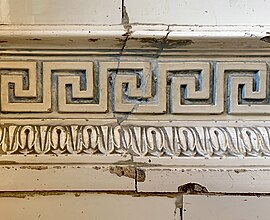
Coins exist portraying the Minotaur on one side, and the symmetrical meander pattern on the other.
Graffiti - It was evidently scratched with a nail or stylus by some idler of 2000 years ago (Pompeii was overwhelmed by Vesuvius in A.D. 79) and is accompanied by the words “LABYRINTHUS. HIC HABITAT MINOTAURUS,” possibly in waggish reference to the owner or occupier of the premises.
Church
Thought
It seems you can purchase portable labyrinths.
In other cases the labyrinth was known as a “Chemin de Jérusalem” “daedale,” or “meandre,” terms which need no explanation. The centre was called “ciel” or “Jérusalem.”
Why did old church Labyrinths exist? Maybe as a symbol of the perplexities and intricacies that beset a Christian’s path. Performance of miniature pilgrimages.
Turf
There is no doubt that the custom of cutting these devices in the turf was formerly very widespread throughout the land, although comparatively few examples now exist. Even during the past generation, as we have seen, some are known to have disappeared.
Floral Labyrinth and Dwarf-Shrub Maze
Floral mazes were fashionable, made with dwarf shrubs and herbs in long narrow beds twisted into various complicated figures.
“Here by the way (Gentle Reader) I do place two proper Mazes, the one before this Chapter, and the other after, as proper adornments upon pleasure to a Garden, that who so listeth, having such roomth in their Garden, may place the one of them, which liketh them best, in that voide place of the Garden that maye beste be spared for the onelye purpose, to sporte in them at times, which mazes being workmanly handled by the Gardner shal much beautifie them in devising four sundry fruits to be placed in each of the corners of the Maze and in the middle of it a proper Herber decked with Roses, or else some faire tree of Rosemary, or other fruits, at the discretion of the Gardener.
Hedge Maze
The art of trimming hedges of evergreens is of great antiquity; probably it is almost as old as horticulture itself.
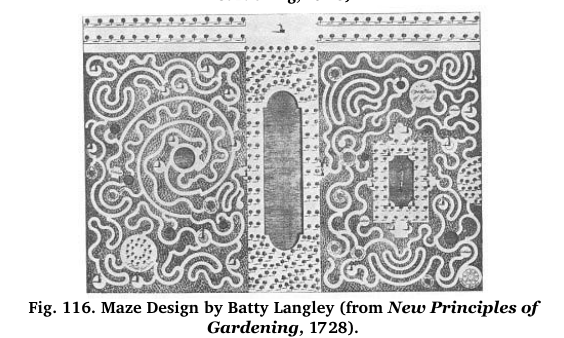
In practically all types of maze it became the fashion to relieve the monotony of the walks by placing statues, vases, seats, fountains, and other ornaments at various points.
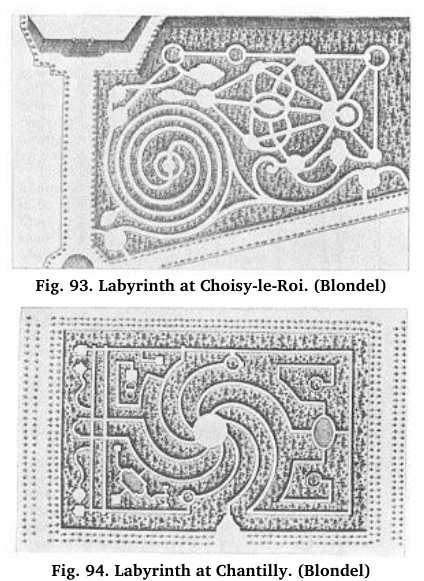
He speaks of the object of a labyrinth as being to provide “an intricate and difficult Labour to find out the Centre, and to be (as the Vulgar commonly like it for) so intricate, as to lose one’s self therein, and to meet with as great a Number of Stops therein and Disappointments as possible;
Stone
In some of these figures the stones employed were small pebbles, in other instances they were as large as a child’s head, and in one case they were so large that they required several strong men to lift them. Some of the figures had nearly disappeared through the action of moss, earthworms, etc.
Names
- Jatulintarha (Giant’s Fence)
- Pietarinleikki (St. Peter’s Game)
- Ruins of Jerusalem
- City of Nineveh
- Walls of Jericho
- Lissabon
- Stone-fence (Kivtarha)
- Babylon
- Völundarhus (Weyland’s House, Iceland)
- Norway (Nun’s Fence, Maiden’s Dance, Round Castle, The Troll’s Castle)
- Stone Dance
- Tröjeborg
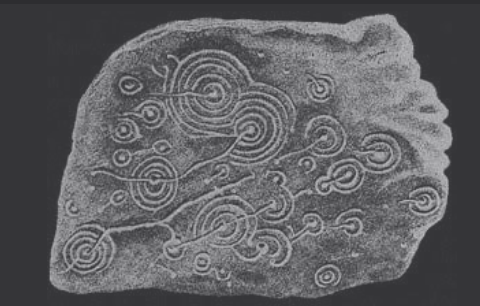
Here the surface of the stones is entirely covered with engraved concentric grooves, which never cross one another, but form systems of whorls very much like those on the skin of human finger-tips.
The Dance or Game of Troy
Association of Troy with the idea of Labyrinth. (troy towns, walls of troy, troja, trojeborg)
the expression “Troy-town” or “City of Troy” was in general use 500 years ago as a title for the Cretan Labyrinth
The figure of the labyrinth is connected with the idea of ceremonial game or dance.
On the strength of a passage in the Iliad,it has been suggested that the palace was the site of a dancing-ground made for Ariadne by the craftsman Daedalus, where young men and women, of the age of those sent to Crete as prey for the Minotaur, would dance together.
Troy Town
Welsh hilltop turf mazes (none of which now exist) were called “Caerdroia”, which can be translated as “City of Troy” (or perhaps “castle of turns”).
Etymology
Bower
 “Bower”: We have here a word of which the early connotation has been rather obscured by poetical insistence upon one of its extensions. As a convenient rhyme for “flower” and “shower” it has become one of the mainstays of the vernal poetaster.
“Bower”: We have here a word of which the early connotation has been rather obscured by poetical insistence upon one of its extensions. As a convenient rhyme for “flower” and “shower” it has become one of the mainstays of the vernal poetaster.
The word has thus come to be chiefly employed to signify a leafy or shady arbour or a recess in a garden, a use quite consistent with, but narrower than, the principal and much older meaning, which was that of a dwelling, with particular reference to the character of privacy.
Labyrinth
Intact from Aegean labyrinthos but the derivation is subject to dispute.
Laura - a passage, or mime
Origin of laura 1720–30; < Medieval Greek laúra ( Greek: lane, passage)
labrys - the two edge axe has pre-eminence to the derivation of labyrinth.
In Renaissance times we find the word commonly used as a simile for the difficulties of life or the vagaries of love.
Maze
Probably of Scandinavian origin: a state of bewilderment and confusion.
Design and Solutions
- must be works of artifice (thus labyrinth of nature such as forest, caverns are excluded)
- there must be purposefulness of the design
- there must be complexity of the design
- there must be communication between component parts (the path continuous)
- there must be communication between the interior and exterior.
Thought
These are rigid and feel dated, or susceptible to counter-example or argument. Most mazes generated now have an algorithmic origin I would say. It’s less a deliberate hand.
Maybe this is specific to human/world mazes, which I can understand but still am curious about alternative IRL maze origins such as ones where passages are inaccessible or discontinuous, or a maze that is built following the path of an animal (the true architect a folly).
I’d actually be more interested in maze examples that avoid one or two of these rules.
The use of the straight-line diagrams suggested above may be found helpful not only as a means of facilitating the study of an existing labyrinth, but also to some extent in designing a new one.
rel:Transmutation and Transformation
How mazes can be transformed into straight line diagrams.

The “goal” of the maze might be the center. It might be escape.
Using the word node to signify a point of branching, and the terms odd and even to describe respectively those nodes at which odd or even numbers of paths are to be found, we see that there must be at least three paths meeting at a point to form a node, for two paths meeting at a point constitute only a change of direction of the path without formation of branches, whilst the arrival of one path only at a point also precludes the idea of “branching” at that point, and can only occur at the end of a blind alley, at the entrance of the maze, or at the goal. We find it convenient, however, to regard the latter arrangement as an odd node of the lowest order, the lowest possible order of even nodes being, of course, that at the meeting of four paths.
Maze in Literature
Spanish Poet Juan De Mena in 15th Century made a ponderous allegorical poem “El Laberinto” In it the poet is shown as being guided by a beautiful woman, symbolising Divine Providence, through three vast concentric circular regions, representing respectively the past, the present, and the future. These are somehow involved with the seven planets, after which the seven divisions of the poem are named.
Some instances use the word Labyrinth to suggest a “Thesaurus” or “Compendium of Knowledge” such as “Labyrinthus Medicorum Errantium” or “Labyrinth of Lost Physicians.”
